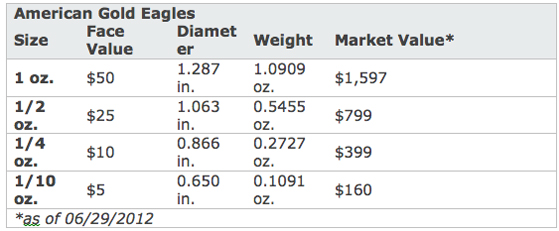Gold investing has been a mainstay for a wide variety of individuals for hundreds of years. From the California gold rush all the way to the precious metal's meteoric rise last year, gold has continued to be arguably the most popular commodity investment in the world. Aside from its high value, gold's appeal comes in the form of a hedge against inflation, a store of value and safe haven asset to protect a portfolio during times of market turmoil. Though recent years have brought popular securities for gold investing, like the SPDR Gold Trust (NYSEARCA:GLD), which has well over $60 billion in total assets, the original means of gold investing, physical bullion, is still a favorite among many [see also Why No Investor Should Own GLD].

Get Physical
Investing in physical bullion is the safest way to ensure you receive proper gold exposure. A number of investors are comfortable with products like GLD, but there are still a number of others who feel that funds of this nature do not actual hold the gold they claim to, or that their stockpile of the precious metal is far lower than what they claim. Stocks, ETFs, and mutual funds can be impacted by factors like trading trends, technological errors, market shocks, problems with the security issuer, and so much more. Physically holding the gold in your hand means the only issue you have to worry about is how to safely store the asset [see also Three Reasons Why Gold Is Overvalued].
Enter the American Gold Eagle coin. For small- to medium-sized investors, these golden discs will offer the best means of adding physical gold to your net worth. Note that it is possible to buy bars and much larger gold deposits, but these come with a hefty price tag that is often above the heads of your average Joe. Instead, investors around the nation have embraced these ultra-popular coins as their main outlet for gold exposure [see also Jim Rogers Says: Buy Commodities Now, or You’ll Hate Yourself Later].
The American Gold Eagle Coins
According to the U.S. Mint, "all American Eagle Gold Proof Coins are legal-tender and contain 91.67% (22 kt) gold. The gold weight, and diameter will vary with each coin denomination, as specified below. Each coin is backed by the U.S. Government for weight and content." Investors can choose from four different sized coins depending how much of their own capital they would like to exchange.

Whether you are a collector or an investor looking to make a serious allocation to protect the value of your cash, the four options given by the government offer a healthy range of coins. It should be noted that there are both advantages and disadvantages to owning these coins. On the upside, you will never have to worry about market issues, massive trades ruining your positions, or technological difficulties standing in your way. But on the opposite end of that, you do have to worry about things like liquidity. While gold will likely never lose its luster, its not as if you can walk up to your computer and make a sell/buy within seconds like you could a normal stock; selling the coins will take a bit more time. That being said, in times of market stops and trading blocks, your coins are the most liquid thing on the market. The final disadvantage to owning these coins is ensuring the safe storage of the hard assets, as it can be a relatively daunting task [see also The Ultimate Guide to Gold Investing].
Storing Gold Coins
This may be the most important aspect of physical investing as the wrong decision for storage could lead to the theft of your gold and the loss of thousands of dollars. One of the first routes that many people take is to put the gold in a safety deposit box at their local bank. While this will ensure the gold being stored in a secure location, it comes with a fair amount of downside. Investors have only restricted access to their box, as they can only access it during the operation hours of their bank. Also note that these boxes are not insured against robbery. For those who are paranoid of another gold confiscation like that of 1933, you should also be aware that a safety deposit box gives the government a relatively good idea of where to look to get their gold. Think it sounds too far-fetched? One author tells of a personal story of someone who lived through the confiscation.
“After Roosevelt declared a two-day banking holiday, the man went to his bank about a week later to check on his valuables. When he opened his safety deposit boxes, which had contained $1.4 million worth of diamonds, precious stones, jewelry, and gold coins, it was empty. He asked the bank president what had happened to his valuables. The man played dumb, and said that he didn’t know. The man walked out the door, went home and committed suicide.”
A second option is to simply bury it. While it may sound ridiculous at first, properly burying the gold can often be the safest way to store it. With the gold out of the house and not in a bank, it will be protected from fires, robbery and the like. Those wishing to go this route will want to take a number of precautions, with the first being to not let anyone see where you have buried your bullion. Make sure you put the coins in something that is airtight in order to keep out the elements, which can damage the coins over a long period of time. And just in case you are extra paranoid, the average metal detector works up to approximately four feet. The downsides to burying your precious metals are quite apparent: limited access, meticulous planning, not to mention keeping the location a secret while still being able to monitor the land for any kind of natural disturbances or construction projects [see also Why Warren Buffett Hates Gold].
The final, and often more popular option, is to hide the gold in your home. While some stick to floorboards and other crafty techniques, a home safe is probably your best bet. The safe ensures that no one else will be able to get to the commodity, while protecting it from mishaps like natural disasters. Self-installation is usually recommended and you should always make sure that the safe is attached to the ground or another fixture; if it was brought in by hand, it can easily be brought out that way if you do not take the proper precautions [see also Is Gold Overvalued? The Bearish Case versus the Bullish Case].
Where to Buy Coins
Below, we outline several resources where investors can purchase gold bullion.
· U.S. Mint: Likely your safest bet as it is a government-run website.
· BullionVault: The world’s largest online bullion market.
· BuyGold.org: Another popular site for gold bugs.
Jared Cummans
ETF Daily News



























































